 In the spirit of Black Friday, let's see if we can save some green. Whether you are guilty of joining the Black Friday "festivities" or not, this lesson contains something for you to be aware of in your shopping with coupons.
If you have multiple coupons, of different discount types (amount discount vs. percent discount, that is), then there is a particular way to apply these savings that will earn more savings than the other.Long story short: Apply the percent discount before applying the amount discount for more savings.
The concept relies on the concept of composition of functions, commonly written in the form f(g(x)). These are functions that evaluate in one functions and then another, in a particular order. The topic puts emphasis on evaluating with the order of operations as well as other properties like the commutative property and associative property, both of which are staples in algebraic concepts.
 Remember, always use the percent discount FIRST when given the opportunity. Teaching this lesson in class works well, mainly due to the fact students get so wrapped up in seeing whether they know how to reap the biggest reduction on their purchases in the future. To help solidify their learning, or ward off skeptics on the topic, we try a couple examples: a $50 purchase and a $100 purchase, for ease of computation. Follow along: For a $50 purchase:- $10 discount applied first: $50 - $10 discount = $40, then $40 - (0.2)*$40 = $32 final price
- 20% discount applied first: $50 - (0.2)*$50 = $40, then $40 - $10 = $30 final price
For a $100 purchase:- $10 discount applied first: $100 - $10 discount = $90, then $90 - (0.2)*$90 = $72 final price
- 20% discount applied first: $100 - (0.2)*$100 = $80, then $80 - $70 = $70 final price
It is no strong coincidence that there is a two-dollar difference between these scenarios. This is the critical piece of what I'm trying to convey with this post (oh, and it's a fun math lesson to teach). In using the dollar-discount first, the consumer or retailer is causing the percent-discount to be applied to a smaller value, therefore not letting it stretch as far as it could otherwise. It is, in essence, as if you are also taking the percent OFF of the dollar discount you wish to use (note the examples above, where there is a $2 difference and $2 is 20% of $10). In applying the percent discount first, your percent covers the larger original purchase price and stretches further. This is the gist of why the percent coupon should be applied first, when you have the opportunity. NOTE: Some retailers have a point-of-sale system which is programmed to use the dollar discount first, no matter when you had a coupon to the cashier, so you might be forced to play their game and sacrifice part of your savings. I will not name names, but have had a couple of disappointed students bring in receipts and show me how much MORE they could have saved if the register didn't force the order of discounts applied. I'm making a bunch of links in this sentence if you would like either the TI-Nspire file I have shown up above in the slideshow, or the original presentation and handout I did for this topic to earn T^3 Instructor status a few summers ago. (Don't have a TI-Nspire? Try running the TI-Nspire file through the TI-Nspire Document Player without a need for download of software.)
 A 101qs.com entry I posted in May, 2012. This was a head-scratcher but good example. I managed to take a trip to an outlet mall, where I saw a curious sale display, pictured at left. To use the word "PLUS" in this instance seemed additionally confusing (yes, pun intended there), and caught the ire of Dan Meyer on his blog shortly after I'd posted the photo to 101qs.com. This, and other sale opportunities like it have been a common cause of commotion in class among my students who have heard me teach this lesson. They are able to bring up new shopping adventures they have had, where they might have corrected the way a cashier had rang something up, or a discount was applied more favorably than they expected, or the discount merely balanced out the sales tax they would have paid anyway. Regardless, the lesson sticks. Applying similar, consecutive discounts have proven to be a decent introduction to exponential growth, since students are aware that "50% off, then another 50% off does not make the item FREE." For those students who are very shopping-savvy, these applications hit home for them much more quickly than any compound interest problem ever could. Speaking of interest, I hope this sparked some of yours. Have a good day and enjoy the holiday season, saving all the while! --Keltner--
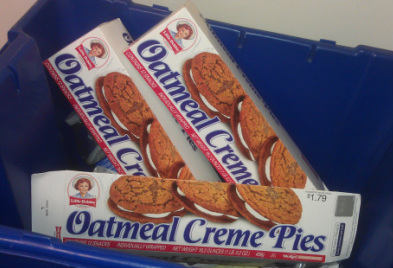 The "after-math" of introducing systems of equations. Delicious pun, huh? Introducing systems of equations about the same time of year as Halloween candy flows freely can be dangerous. I tried to use students' sugar cravings to introduce the topic in class though. I have a sweet spot for Little Debbie's Oatmeal Creme Pies and noticed a peculiar pricing setup betwixt their Single Decker and Double Decker snacks. At a budget-friendly price, I was able to bring snacks for my students to help solidify their work on the example we posed to introduce systems of linear equations. Gimmicky, I know, but it definitely grabbed their attention, wondering why I brought snacks that day.
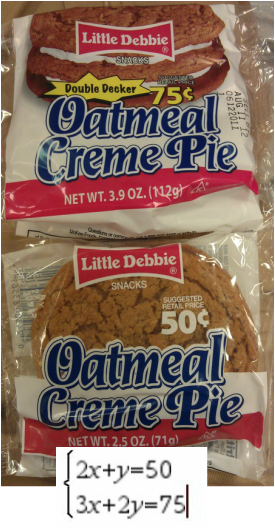 The rest of the example relied heavily on the photo at left, which showed two different "recipes" of Oatmeal Creme Pies available at our local convenience store, one the traditional Single-Layer-O'-Creme and the other the legendary Double Decker. This gave students a familiar context and placement of the example and led to a pretty casual conversation that was more engaging than cracking open the textbook, without a doubt. We investigated several things about the snacks: - Does the weight matter for the price (hinting at a use of direct variation which we had studied previously)?
- What are the things about the snacks we CAN change and which things are non-negotiable? (i.e. what are our variables and our constants in this scenario? I was proud they got this outlined so quickly.)
- Is there a more efficient way to solve for the cost per cookie layer and cost per creme layer?
So, with hook baited, we entered into the strategies for solving linear systems of equations, notably in this instance the substitution method. We set up the system of equations at the bottom of the graphic at left and solved, arriving at an astonishing revelation: The creme layer costs ZERO cents!(The cookie layer costs twenty-five cents, as we discovered.)Students had a hard time wrapping their heads around this, thinking more of the context or production costs until another classmate emphasized that our goal was to figure out the PRICE for each cookie and creme layer, not the COST.This was a decent introduction to the idea of a solution for a system of equations, because students emphasized to one another that zero cents for a creme layer did not make much sense on the surface, but the pricing structure we solved for WORKED with the label price of each snack (made a true statement). When I had to back up and give a concrete definition for what a solution to a system is, students had already seen it used in context and had a more concrete understanding of how it worked in the abstract sense of the topic.I hope you enjoy this example as much as my students did. Without a doubt, timing during the school day was critical with this example. Oh, a side note: I did not use the Oatmeal Creme Pies as pictured; I bought 12-packs that were a bit smaller but still grabbed students' attention just as well. For now, I need to run. Just reflecting on this lesson is making me hungry.
--Keltner--
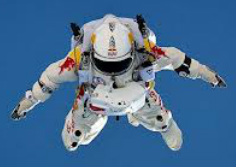 Click for Red Bull Stratos mission website. For the casual observer--well, hang on--no one casually observed Felix Baumgartner's jump from the edge of space on October 14th, 2012. Not everyone who watched had their mind racing like mine was, but I am certain that this feat is one more than befitting of #101qs and #3Acts formatting. What follows on this post is what I have managed to use in my own class to help quench students' curiosity about the Red Bull Stratos project, which sent a helium-filled balloon up to 128,100 feet and had Austrian skydiver Felix Baumgartner jump back to the Earth wearing a pressurized suit.
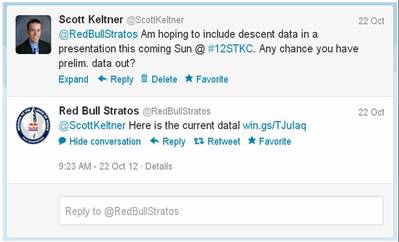 I got a response back from Red Bull Stratos! This coming Sunday morning, I will be presenting at the STEMtech Conference in Kansas City and was hoping to use an example from the Red Bull Stratos jump within my talk to show how velocity, acceleration, deceleration, and time can relate to one another--both for the balloon's ascent and Felix's descent back to the Earth. So, I tweeted the Red Bull Stratos folks. With 240,000+ followers, I figured it had fallen on deaf ears (although, since they're used to travelling faster than the speed of sound, they could use "I couldn't hear you" as a valid excuse). Nevertheless, I set out to collect some data points for use on the TI-Nspire CX using the Teacher Software. Below is a slide show of some of the work I completed. What I hoped students would take away from these graphs included: - The balloon appears to make a fairly constant ascent, but careful inspection would reveal the upward velocity of the balloon actually varied much more than at first glance.
- Does the elevation vs. time graph of Felix's descent convey enough information for us to know when he deployed his parachute? (This would be a great time to introduce the idea of a secant line to students, as a BRIEF introduction to a Precalculus and Calculus topics such as average rate of change and limits)
- Does the velocity vs. time graph of Felix's descent show enough to let us identify when he is accelerating and decelerating, when his parachute was deployed, and when he touched earth again?
Also, I'm including a link to the data I used to compile this activity on this post both as a Google Docs Spreadsheet and a Microsoft Excel file, and also the TI-Nspire CX document used here (this can be downloaded, then viewed within the TI-Nspire Document Player without needing software purchase or download of trial versions). Please use either however you see fit and let me know how it works for your class. The ascent data was gathered from this post on Wikipedia. The descent data was gathered by watching and pausing this YouTube video a couple different times (NOTE: these were approximate velocities and subject to verification and should not be considered 100% accurate, but did work well enough to conduct the lesson I was looking to convey).
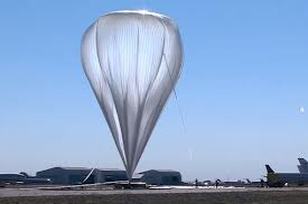 Click for more information on the Red Bull Stratos balloon. The other information I wanted to include in this lesson, but did not focus on in this lesson, included facts and figures about the balloon used in the Red Bull Stratos mission. At lift-off, the balloon was nearly 200,000 cubic feet (or 100,000 Giant Jenga games, as I was able to illustrate with my students in class, since we recently worked with it). At its highest point, the balloon was nearly 30,000,000 cubic feet large (which I related to my students by having them envision a cube that is as long, wide, and tall as a football field--a cube with side lengths about 310 feet on a side). Check this blog post on how the balloon compares with the Statue of Liberty When we approach a lesson that involves transformations of solids (impact on volume and surface area when a single dimension is altered), I will likely revisit this topic again with a different focus in mind. As much energy as my students brought to this lesson, then finding out that there were over 8 MILLION simultaneous YouTube viewers of the Red Bull Stratos mission (which was not mentioned on the mission's blog post among the other records and noteworthy feats achieved), I knew that this was a topic that would grab their attention. I also know how much my own mind was racing as I was watching the broadcast of the mission, so to leave it alone would be unheard of. But when the speed of sound was broken during the fall, that is the play on words I was hoping for: "unheard of." Mission accomplished. Thank you for being a great example to our students, Felix Baumgartner! Wait! An example in a lesson, I'm not saying that all our students should go jump in balloons and take up this sort of skydiving! There. I have to cover that segment of the population that will try and one-up this record by any means necessary. --Keltner--
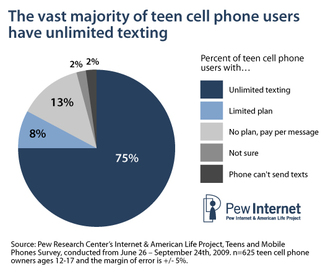 OMG, Unl. TXT FTW!!! I like how this site uses a question posed by a student, akin to "How do I graph a function that has a changing slope?" The example quickly divulges to cell phone pricing structure, a valid place to go The issue I have with their example is that the majority of my students who have cell phones and an awareness of these pricing structures realize quickly how outdated the example is and lose engagement in the class discussion. Cell phones make calls, true; however, the majority of the usage my students' phones see is by text messaging, which most of them have a HUGE allotment of messages per month by their phone plan (many of whom will have unlimited texting anymore). So while the cell phone pricing examples are valid examples to introduce piecewise functions in a context familiar to students, they are quickly outdated by the rapidly changing face of technology today. The Khan Academy example I found that lends itself to piecewise functions takes almost 3 minutes to get the example drawn on the screen (while Sal says twice "I hope I'm not boring you while I'm drawing this" and also "I really should have something that lets me just get the graph image in place quickly"). I have to be a bit lenient, though, because his video was posted in 2007 which is better than I was doing back then (I was, however, using a SMART Board regularly in daily class activity though and feigned a couple efforts at uploading my stuff). Students become quickly detached from examples in their textbook and I would have a hard time justifying asking them to watch a 9-minute KA video where the first 3 minutes are setting up the example.
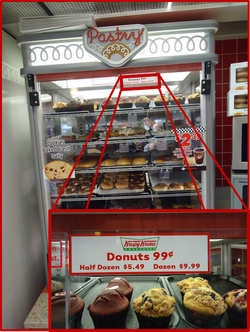 I visited the convenience store in town and compiled this photo (the one pictured above left) of their donut case, which indeed exhibits the characteristics for a piecewise function (while also allowing us to discuss the greatest integer function, since we can only purchase whole number quantities of donuts). I simply project the image in class when they come in and have already set the scene for the lesson, despite having to address the "So, we're taking a field trip today?" and "Did you bring snacks?" comments from students as they arrive. [NOTE: The amount of time showing this image in class should be inversely proportional to the amount of time to the nearest meal for your students.] Have students create a price table for the quantity of donuts purchased, from 0 to about 15. They get an interesting surprise around the dozen-donut mark (namely that 11 donuts costs $10.44 and 12 donuts costs $9.99--so it is as if the 12th donut earns you a $0.45 refund!). These sort of conclusions are ones students treat as an inside joke among their other classmates, so don't sell it short despite the nerdiness it entails. Since we're supposed to help our students make real-world connections, this is a prime example--and a delicious one, to boot.
 Krispy Kreme price chart. Have students construct it and see if they notice anything around the dozen-donut mark. In the video examples I complete below using foldables, I try to emphasize that each of the PIECES of the function could stand alone by themselves with no restriction on their domain(s). With a piecewise-defined function, we are merely piecing together the parts of the individual functions that are requested in the piecewise function that DOES specify constraints on the individual component functions.
 This is the example worked out in the YouTube video below. A copy of the foldable used for a 2-piece piecewise function can be found HERE.
 This is the example worked out in the YouTube video below. A copy of the foldable used for a 3-piece piecewise function can be found HERE.
Obviously, I need to develop a better way to make a quick demo of lessons like this. These were each done on my iPad2, so I'm pretty pleased with the capability of them to collect decent sound and video. What I did not show were the cue cards I created for myself just behind the iPad so I could more quickly graph and plot the functions (something Sal did not do on his example I mentioned earlier). Oh, and I included a shout out to Vi Hart for having used Sharpies for both of the videos. So, I've got that going for me, which is nice. Piece, I'm outta here. Yes, I misspelled that. I meant to. Math puns are hard, I gotta take what I can get. --Keltner--
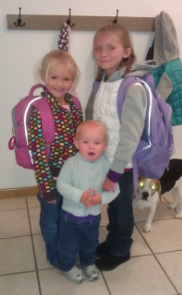 Doctor-approved backpack weight? I came to our lesson on linear inequalities in two variables, which coincidentally closely follows our discussions on direct variation, scatter plots, and linear regression. I wanted to find a unique real-world application for the lesson that tied these two topics together. I found a blog post for the New York Times wellness section that gave a decent path HERE: the relationship between student body weight and their backpack weight. The American Academy of Pediatrics recommends the student's backpack " never weigh more than 10 to 20 percent of your child's body weight." Consumer Reports insists that a backpack weigh no more than 10% of the student's body weight (I feel it necessary to point out that the emphasis of their claim seemed to be focused on elementary school-aged students; their insistence seemed to loosen up on secondary students, citing that their back muscles are stronger at those ages and better fit for a bit more extreme load). So, enter the lesson, sans the lab coats and clipboards that the Consumer Reports folks might have access to, and determine: Are my students' backpacks in compliance with the most extreme of these doctor recommendations?
I've created several activities that are intended to accompany this activity. Here are some of them: - TI-Nspire CX activity [If you do not have TI-Nspire Teacher Software to open this file, download the file first, then use the TI-Nspire Document Player to view it without need for purchase or download] The activity will walk students through analyzing their class's data (NOTE: The teacher should note the slideshow at the bottom of this post for pointers as to how this activity is set up. Student weights are "hidden" on the first/title page of this document), as well as a couple of final Self-Check questions to conclude the lesson with a check for understanding.
- GeoGebraTube post for the graph and spreadsheet to display a class's data, showing the Compliant and Non-Compliant regions as they pertain to doctors' recommendations regarding this weight relationship.
Please note the slide show below for images of each of these activity resources with captions to help give pointers as to the intent of the activities as well as user tips and tricks. 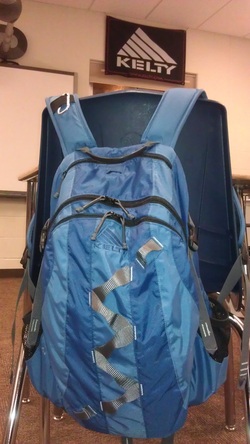 Some helpful tips on successfully executing this lesson: - Don't forget to use an accurate scale! I was able to call in a favor with our school's wrestling coach and use their official scale since this lesson happened to fall during their off-season. Especially helpful--since some students were bashful about their data being seen by others--was the fact that the scale had a detachable display screen which could be faced away from their peers.
- Yes, I indulged a bit when using the TI-Nspire CX's (especially since we actually were able to use the CAS version of them). They work great this early in the school year to grab students' attention and quickly engage them in a topic like this one. I otherwise would use a similar activity using the TI-84s we have access to.
- I do not mean to play down the power of GeoGebra in this post. It is a very visual tool and my students have enjoyed it in many other lessons, but it was dependent on me having contained my lesson within a separate file, in this case a PowerPoint. No big deal, but with a couple of network snafus among one of my larger class sizes, I revised last year's lesson plan to instead use the TI-Nspires this time around.
As for the photo at the left of my backpack and the banner above my classroom window (both KELTY, by no coincidence): there's no real rhyme or reason, I just wanted to give a shout out to the company. I still have students who believe I faked both products so that I could dub myself with a pretty sweet nickname. Well, who's laughing when my endorsement deal with them rolls in? Right? Hint, hint... --Keltner-- I mean, Kelty
I feel obligated to include some sort of reference to "The Wizard of Oz," being that I have lived in Kansas my entire life. I try to take advantage of my students' familiarity with the film in several instances though. One of my favorite such examples is when the Scarecrow inaccurately recites the Pythagorean Theorem once a brain is decreed upon him (note also how Scarecrow magically moves from the middle of the characters to the far right of the frame after confronting the Wizard). His mishap is recreated by a glasses-wearing Homer Simpson who makes the same mistake, but is corrected by a gentleman in the bathroom stall behind him.  Another mention of "The Wizard of Oz" in class comes up when I emphasize to my students how absolute value measures the distance a number is from zero on a number line. We cannot have a negative distance, so an absolute value will always be non-negative (when a student usually tries to correct me and say "You mean greater than or equal to zero" and suddenly finds that the statements are equivalent).
I paraphrase what the Scarecrow said when first meeting Dorothy (pictured at left): "We can go both ways." The same can be said of absolute values, in that they measure the same distance from a central reference point; in the general case, a number's distance from zero.
In introducing the concept of absolute value this year in Algebra 2, I emphasized greatly the importance of that feature, that absolute value equations would measure the same distance from a central reference point. Refer to the example here:
Solve the equation | x - 2 | = 3. Check your solutions in the original equation.
 Diagramming "a number whose distance from 2 is 3 units." I interpreted the equation, telling them that it is asking, in Algebra terms, "What number's distance from 2 is 3 units?"
They started talking, but only focusing on using that distance in the positive direction, citing 5 as the only solution. This diagram helped them clarify that -1 is also 3 units away from 2. We substituted each value back into the original equation to check our work and conclude that each apparent solution was indeed a valid solution (a great time to introduce the idea of extraneous solutions and emphasize how our conclusion would have differed if we were discussing money, volume, unit sales, and other applications.
I then decided to give an open-ended task to end class that day. I asked students to find something in real life around them that involved the same distance away from a central point. The example I gave was that I parked my car that morning so it was the same distance away from the striped lines on each side of my parking spot, making sure to point out how disappointed I would be if all students returned the next day having simply taken a photo of their car in the parking lot. They came through with some great examples, as shown in the slide show below.
Students brought their cell phones to class and were able to display a screen shot using the IPEVO Point2View document camera I have on my desk (they are excellent for what I use it for and allow quick, easy interface via USB interface including quick screen shots when desired). They were able to sketch on top of their photos using the SMART Board in my room as well, even being able to accept suggestions from classmates on examples of absolute value within their own photo that they had not acknowledge. I aim to do more of these sort of open-ended, scavenger hunt-like examples where students find examples of math around them. I'll call it "Have My Stu's Do A 101Q" to give proper credit to Dan Meyer's 101qs.com website for posting examples of photos meant to drive student curiosity. I might even be able to coerce some of them into posting to Twitter with a class-named hashtag. Only time will tell. Like the Scarecrow said, it "could go both ways." --Keltner--
|

















 RSS Feed
RSS Feed